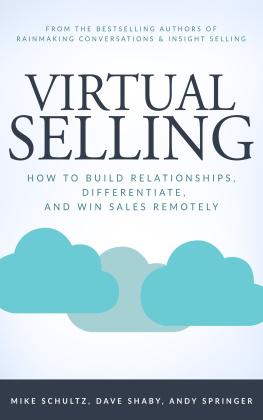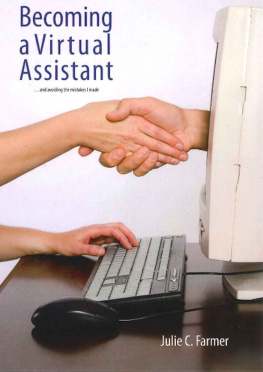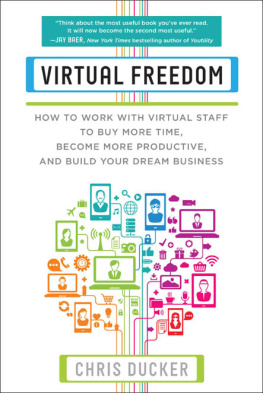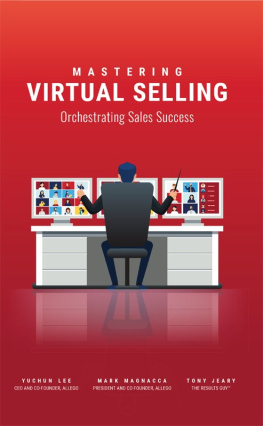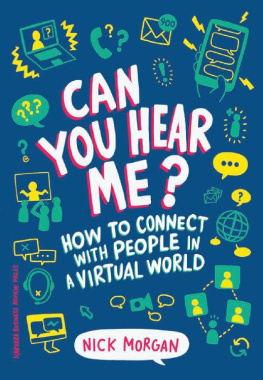Contents
Guide
Pagebreaks of the print version

Also by Kerry Johnson

New Mindset, New Results
Why Smart People Make Dumb Mistakes With Their Money
Willpower
Mastering Self-Confidence with NLP
Phone Sales
Sales Magic
How to Read Your Clients Mind
Peak Performance
Trust-Based Selling
The Referral Mindset
MASTERINGTHE VIRTUAL SALE
7 STRATEGIES TO EXPLODE YOUR BUSINESS IN THE NEW ECONOMY
Kerry Johnson,MBA, Ph.D.


Published 2021 by Gildan Media LLCaka G&D Mediawww.GandDmedia.com
MASTERING THE VIRTUAL SALE. Copyright 2021 by Kerry Johnson. All rights reserved.
No part of this book may be used, reproduced or transmitted in any manner whatsoever, by any means (electronic, photocopying, recording, or otherwise), without the prior written permission of the author, except in the case of brief quotations embodied in critical articles and reviews. No liability is assumed with respect to the use of the information contained within. Although every precaution has been taken, the author and publisher assume no liability for errors or omissions. Neither is any liability assumed for damages resulting from the use of the information contained herein.
FIRST EDITION 2021
Front Cover design by Tom McKeveny
Interior design by Meghan Day Healey of Story Horse, LLC
Library of Congress Cataloging-in-Publication Data is available upon request
eISBN: 978-1-7225-2670-2
10 9 8 7 6 5 4 3 2 1
Contents
Introduction COVID-19 Changed Everything
When COVID-19 hit the United States in February 2020, business soon stopped around the world. The only observable transactions were essential establishments such as grocery stores, gas stations, and hospitals. When Trump Administration Vice President Mike Pence announced from the Oval Office in 2020 that the US economy would shut down for fifteen days, everybody was scared but understood the need to stay home. Hospitals would be overwhelmed. Millions would die on the streets if the illness spread too far.
After two weeks, the shutdown was extended to forty-five days, and most realized this was going to be a longer-term pandemic. Forty-five days extended in many states to eighteen months destroying more than 36 percent of customer-facing businesses like restaurants, gyms, hair salons, and bars. That was the situation by March 2021. As of this writing, the economy has slowly reengaged. But lasting changes in the way business is conducted are the result.
Client-facing businesses as well as many others were scrambling to adapt. They did everything possible to survive including wearing masks, installing barriers, and even buying massive shelters for outdoor service. While many restaurants and bars went out of business permanently, many have adapted. Some even thrived. Those that survived learned a new way of connecting. They discovered a way of maintaining engagement and even found their sales could increase.
How Long Will the Virtual Sale Be with Us?
How long will we be conducting business virtually, or is business virtually part of the new normal? In the beginning of 2020, many of us thought the pandemic would last until the end of summer 2020. But as months dragged on, lockdowns progressed. It became apparent that the pandemic would be with us for more than a year. There were some windows of face-to-face opportunity in early summer 2020. But by the fall, many locations were required to lock down.
In a Wall Street Journal article at the time, the writer speculated that corporate business travelers were flying much less frequently than in prior years. Leisure flyers were still visiting relatives and taking short vacations. International travel to Europe was prohibited for more than a year. Many experts believe that business travel will recover to about 36 percent of what it was pre-pandemic. While this was terrible news for the airlines, it also meant that doing business virtually is with us to stay. Even after the pandemic is behind us, most meetings will be filtered by a layer of scrutiny to see if they are truly necessary.
Virtual meetings are obviously much less expensive than airline travel to a distant city. It will take some time before companies realize closing ratios have taken a pandemic hit. Most salespeople suffer from their inability to meet face-to-face. Marginal revenue sales calls may never recover. High-ticket sales are indispensable and will recover the fastest.
The WSJ article estimated that the loss from sales trips was about 20 percent of a companys income. Conventions and trade shows continue to snap back much faster since they are seen as efficient ways of meeting new prospects and clients.
The airline model of depending on business travel for profits has taken a hit. There was already a move by major carriers like Delta, United, and American to operate more like discount carriers such as Southwest, Spirit, and Frontier. The no-frills airlines were already operating at much less cost than legacy carriers. As mainline carriers attracted fewer business travelers, there were fewer upgrades, smaller seats, and generally less comfortable airplanes. This was in response to less business demand and lower marginal income. There was even talk by one of the big discounters of selling standing seats for flights of less than two hoursone more way of packing passengers in like sardines.
The same innovation cannot be said of many salespeople. Im a business coach working with small business owners in nearly every industry. Its amazing how many clients became paralyzed at the beginning of the 2020 pandemic.
One company based in Dallas had looked for new business solely by booking appointments at estate planning seminars. But in a COVID-19 environment, few prospects were willing to attend in-person seminars. The company was paralyzed, not able to produce enough new sales.
I suggested to the president and chief executive a way to bypass seminars and generate new sales from their client database of 30,000. The process was simple. They needed to keep in contact with their current clients. I taught the thirty-plus sales force a way to call every three months. The skill set was called the Three-Month Phone Call Script.
It worked like a charm. Those sales producers who were disciplined in using the script effectively closed 38 percent of all prospects they spoke to. It was a raving success. It was an answer to surviving the crisis. But only five or six of the thirty were disciplined enough to dial. The president was enthusiastic about calling clients. He even celebrated the concept on a weekly conference call, but that was it. The culture of the company had been to see prospects face-to-face. When the world changes, sales strategies must adapt.
I coached ten groups of three participants on each call. One of the attendees was emblematic. I introduced the Three-Month Phone Call Script to Jim who was enthusiastic. He committed to calling three clients per day, no matter what. When I followed up on his progress the next week, he only produced excuses. Each week he promised to make the calls. On one coaching call, he pushed back that nobody would answer the telephone. When I pressed him to make more dials the fourth week, he ran out of excuses. I realized that Jim was unwilling to make the calls, even though a third of his colleagues had sales increases of 38 percent using the same method.


